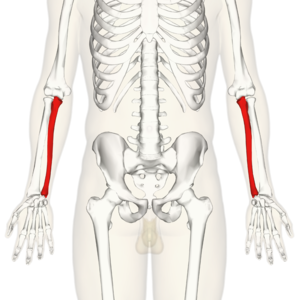Ulna: Difference between revisions
Abbey Wright (talk | contribs) No edit summary |
Abbey Wright (talk | contribs) No edit summary |
||
| Line 7: | Line 7: | ||
== Description == | == Description == | ||
The ulna is one of two bones that make up the forearm, the other being the [[radius]]. It forms the [[elbow]] joint with the [[humerus]] and also articulates with the radius both proximally and distally. It is located in the medial forearm when the arm is in the anatomical position. It is the larger of the two forearm bones. | The ulna is one of two bones that make up the forearm, the other being the [[radius]]. It forms the [[elbow]] joint with the [[humerus]] and also articulates with the radius both proximally and distally. It is located in the medial forearm when the arm is in the anatomical position. It is the larger of the two forearm bones.<ref>Gray HFRS, Gray's Anatomy 15th edition, New York, NY: Barnes & Noble,2010. p120-126</ref> | ||
=== Structure === | === Structure === | ||
The ulna is a long bone larger proximally than distally. | |||
==== Proximal ulna ==== | ==== Proximal ulna ==== | ||
The proximal ulna is hook-like in form which articulates with the trochlea of the humerus.<ref>Palastanga N, Soames R. Anatomy and Human Movement, structure and function 6th edition, London, UK: Churchill Livingstone Elsevier ,2011. p45</ref> | |||
== Function == | == Function == | ||
Revision as of 11:54, 29 September 2018
Original Editor
Top Contributors - Abbey Wright, Kim Jackson, Chrysolite Jyothi Kommu, Rishika Babburu and Joao Costa
Description[edit | edit source]
The ulna is one of two bones that make up the forearm, the other being the radius. It forms the elbow joint with the humerus and also articulates with the radius both proximally and distally. It is located in the medial forearm when the arm is in the anatomical position. It is the larger of the two forearm bones.[1]
Structure[edit | edit source]
The ulna is a long bone larger proximally than distally.
Proximal ulna[edit | edit source]
The proximal ulna is hook-like in form which articulates with the trochlea of the humerus.[2]







